OWC ThunderBay 4 with Thunderbolt 2
Support Manual
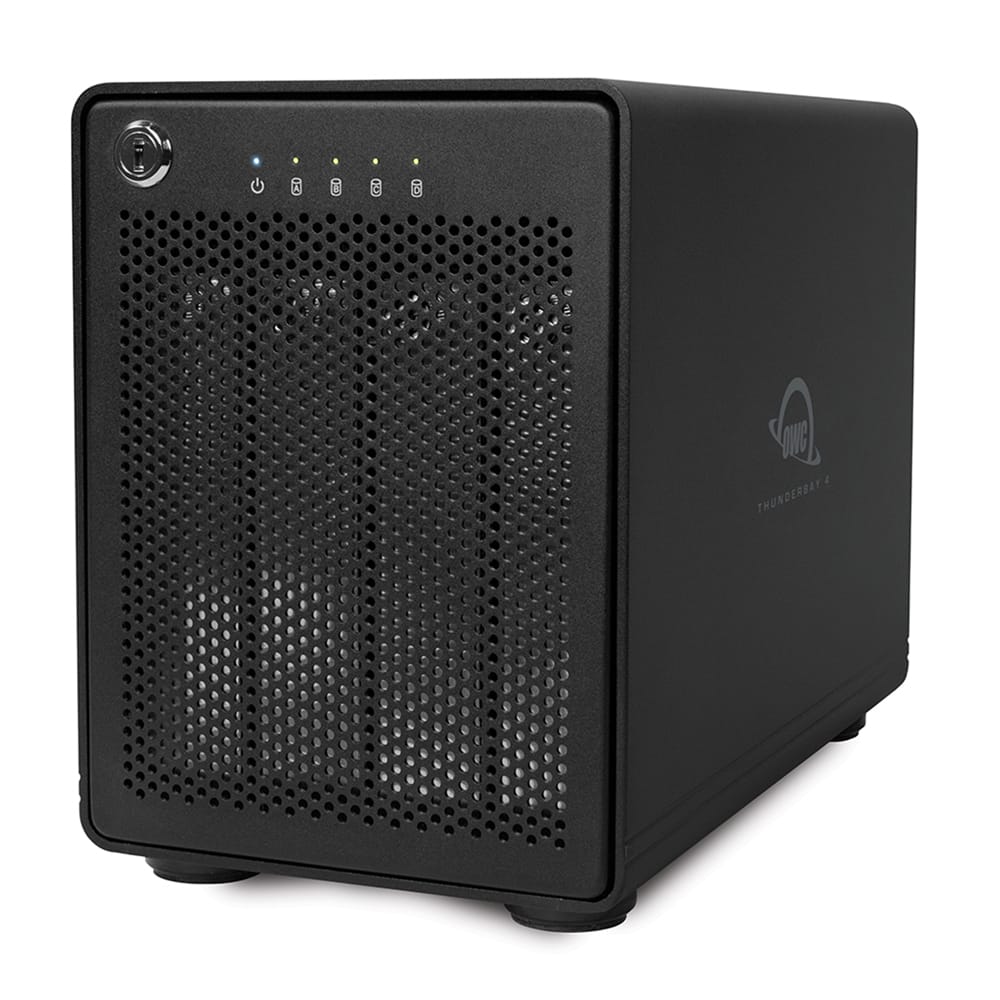
Introduction
1.1 Minimum System Requirements
Mac Requirements
- OS X 10.9.3–10.11.6; macOS 10.12 or later
- Any Mac with a Thunderbolt port
- Thunderbolt 2 port recommended for best performance
PC Requirements
- Windows 7 Service Pack 1 or later (Boot Camp is not supported)
- Any PC with a Thunderbolt port
- Thunderbolt 2 port recommended for best performance
Supported Drives
- Any 2.5-inch or 3.5-inch SATA drive
1.2 Package Contents
- OWC ThunderBay 4 with Thunderbolt 2
- Thunderbolt cable
- Power cable
- Security keys
- 3 Years of SoftRAID Premium Access (License located on bottom of device)
1.3 About This Manual
The images and descriptions may vary slightly between this manual and the unit shipped. Functions and features may change depending on the firmware version. The latest product details and warranty information can be found on the product web page. OWC’s Limited Warranty is not transferable and subject to limitations.
1.4 Front View

- Locking faceplate — Use the included keys to lock or unlock and remove the faceplate.
- LED indicators — See the chart below for LED details.
| LED | Color | Power On | Sleeping | Drive Activity | Drive Bad/ Bay Empty |
|---|---|---|---|---|---|
| Power | Blue / Amber | Solid blue with active data connection | Amber | N/A | N/A |
| Drive (A, B, C, D) | Green | None Active | None Active | Flash Green | None Active |
1.5 Rear View
- Security slot — Connect a security tether here.
- Thunderbolt 2 ports — Attach the included Thunderbolt cable to one of these ports and to your computer, or to another Thunderbolt device. Use the other Thunderbolt 2 port to add more Thunderbolt devices to the chain.
- On/Off switch — Turn the power on and off using this switch.
- Power input — Connect the included power cable here.
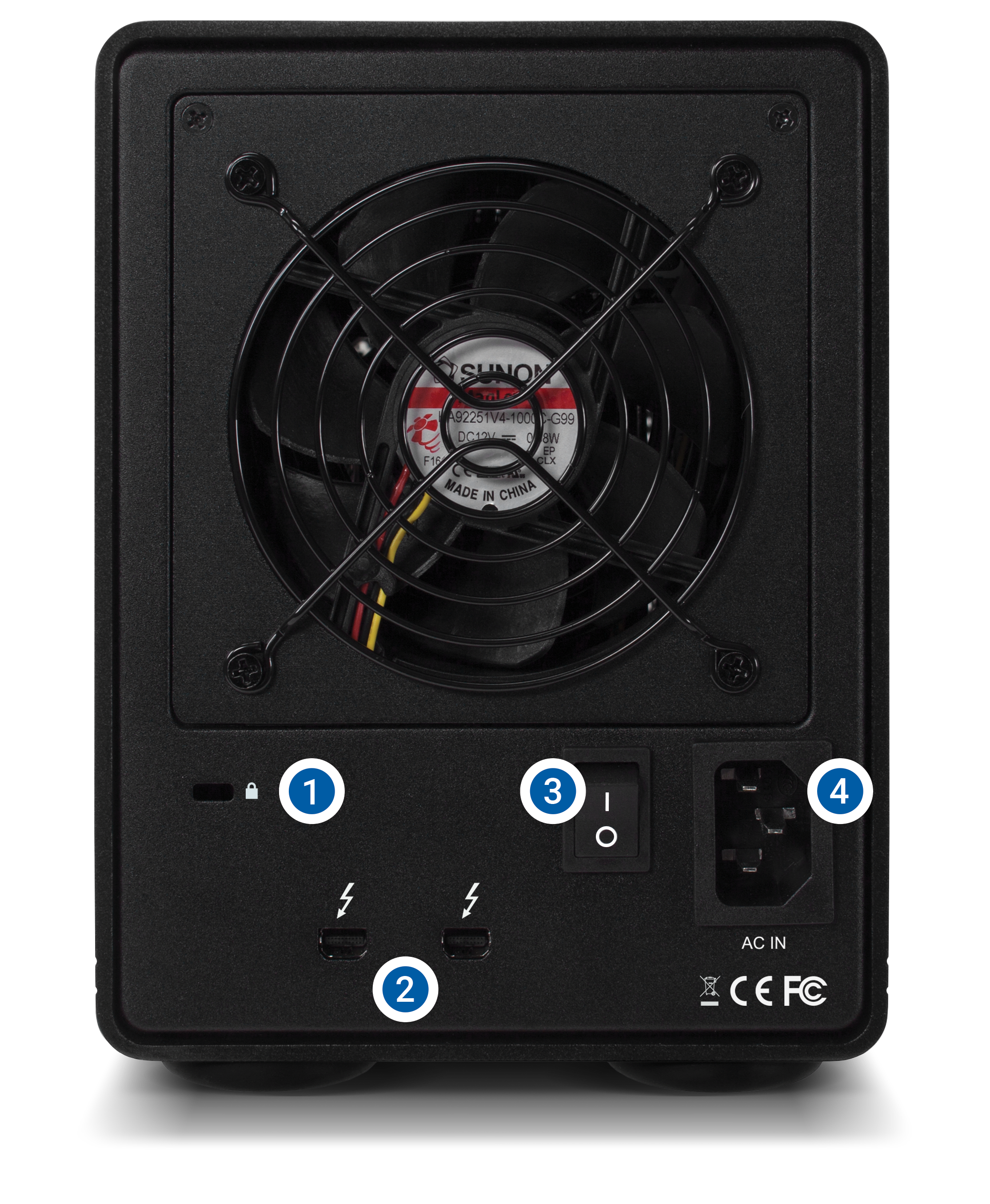
1.6 Usage Notes
- Although the ON/OFF switch controls power to the device, the OWC ThunderBay 4 requires an active data signal for powered operation. As long as the ON/OFF switch is in the ‘ON’ position, the ThunderBay 4 will turn on when it receives a data signal through the Thunderbolt cable. If there is no Thunderbolt cable connected, or if the computer is off or in a sleep or hibernation mode, the ThunderBay 4 will turn off and its power LED will turn orange to indicate that it is not receiving a data signal.
- In order to use any Thunderbolt devices chained through the ThunderBay 4, the ON/ OFF switch of the ThunderBay 4 must be in the ‘ON’ position.
- For the safe removal of your drives and to ensure that no data is lost, always eject or unmount the drives from your operating system before unplugging the ThunderBay 4 or removing the drives.
- Thunderbolt device chains can support up to six Thunderbolt devices.
- Thunderbolt 2 is backwards compatible with Thunderbolt, but any devices connected in a Thunderbolt chain after a Thunderbolt device will operate at original
- Thunderbolt speed (10Gb/s) rather than Thunderbolt 2 speed (20Gb/s). If mixing
- Thunderbolt 2 and original Thunderbolt devices, make sure all Thunderbolt 2 devices are in front of the Thunderbolt devices (i.e. computer>Thunderbolt 2 devices>Thunderbolt devices).
Device Setup
If you purchased the ThunderBay 4 with drives, they have been installed prior to shipment — please skip to Section 2.2 Quick Start, Step 4. If you are installing your own drives, follow the steps in Section 2.1 Hard Drive Installation to install 3.5-inch hard drives into your ThunderBay 4 enclosure, or to replace existing 3.5-inch drives. Note: it is possible to install 2.5-inch SATA drives using the fine-threaded screws that are included (16 in total), and the four screw holes on the bottom of each drive tray (highlighted in step 5 below).
2.1 Hard Drive Installation
Follow these steps to install hard drives into your ThunderBay 4 enclosure, or to replace existing drives. Repeat steps 1 through 8 as necessary for each drive you are installing.
1. Insert one of the included keys into the lock on the upper left of the faceplate.
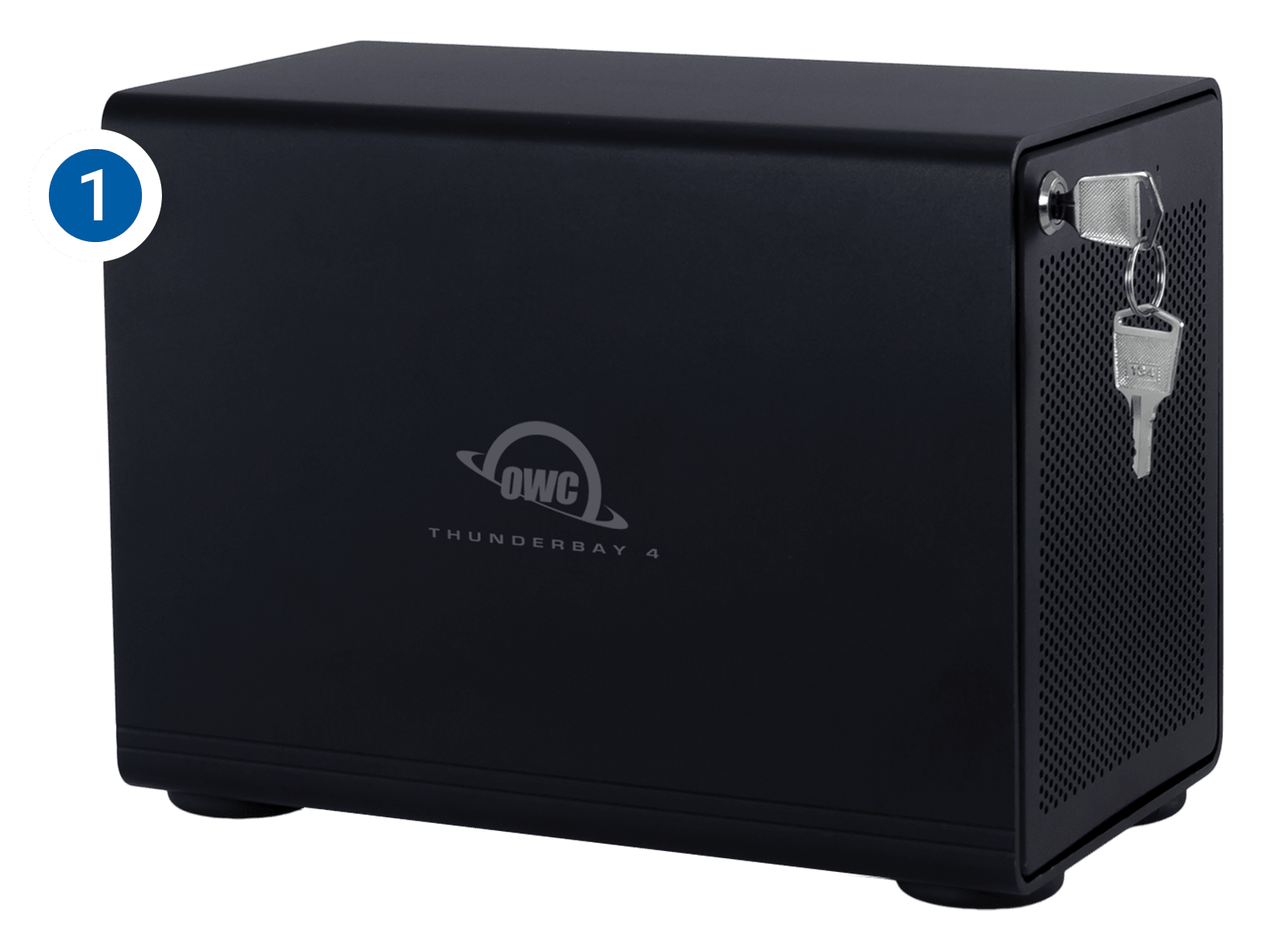
2. Turn the key clockwise, then pull it towards you. The faceplate will swing open, as shown.
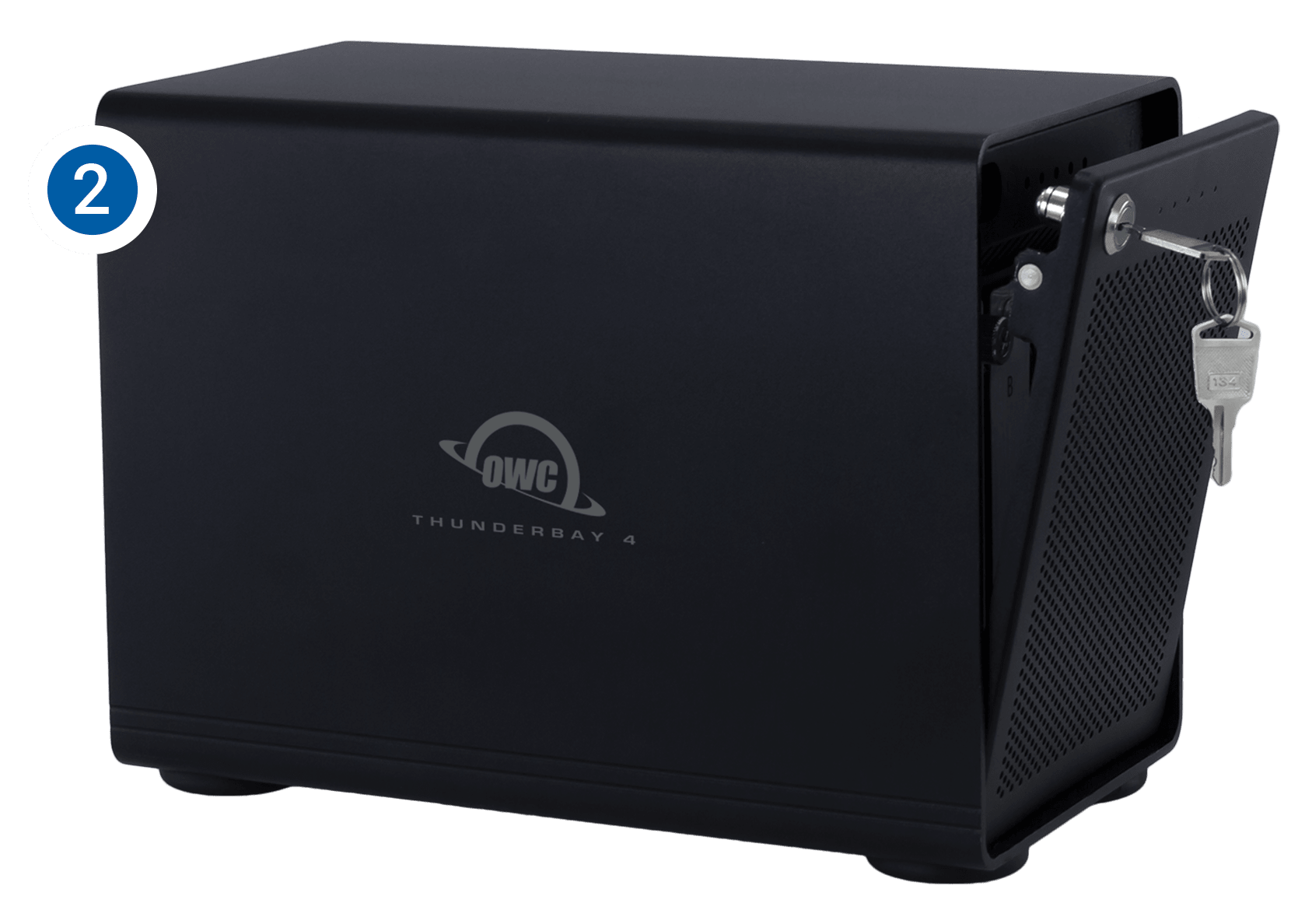
3. Once the faceplate has swung open as far as it will go, pull up to remove it.
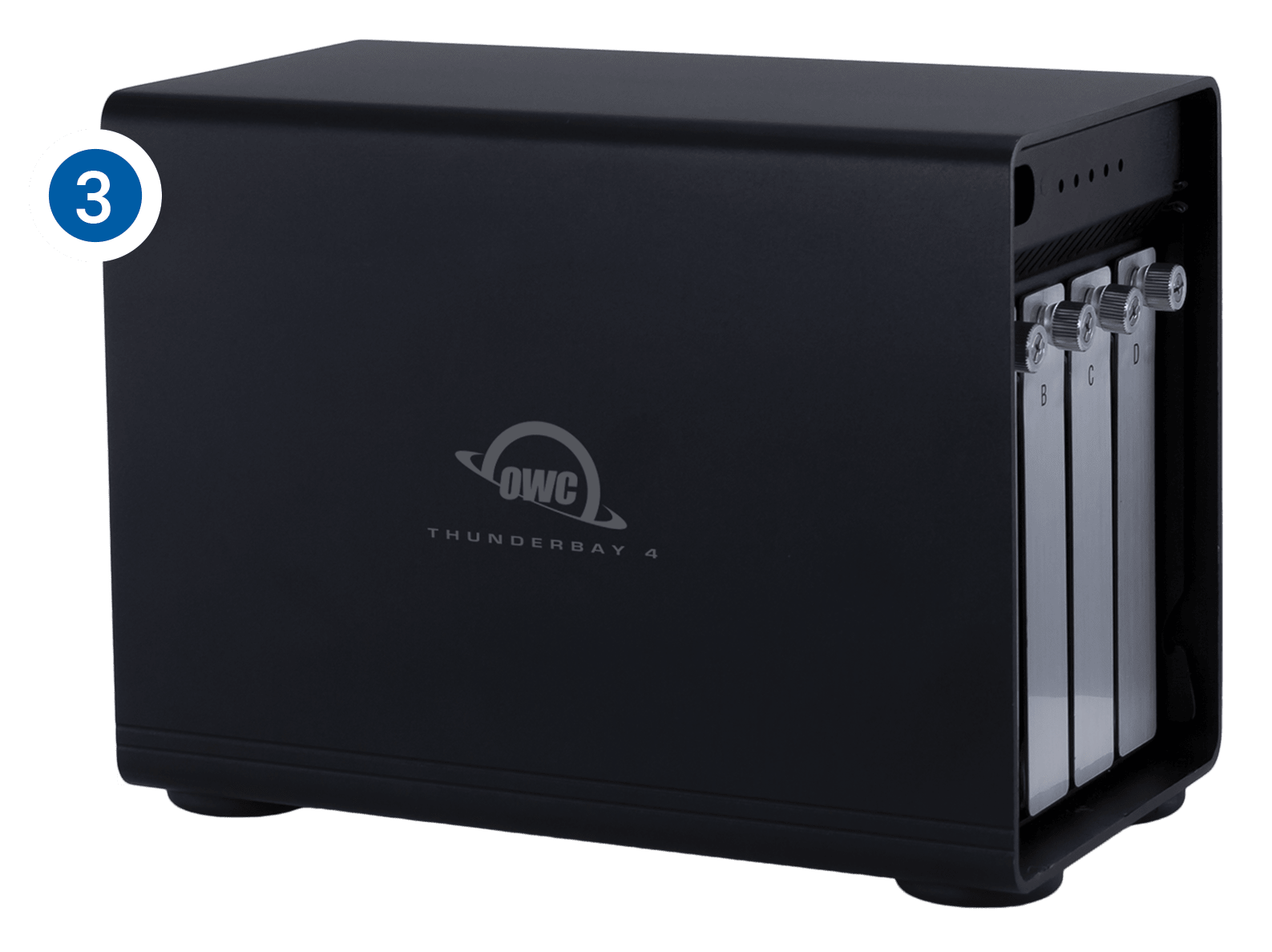
4. On the drive tray you wish to remove, turn the thumbscrew counter-clockwise until you no longer feel resistance. Then hold onto the thumbscrew and pull the drive tray out.
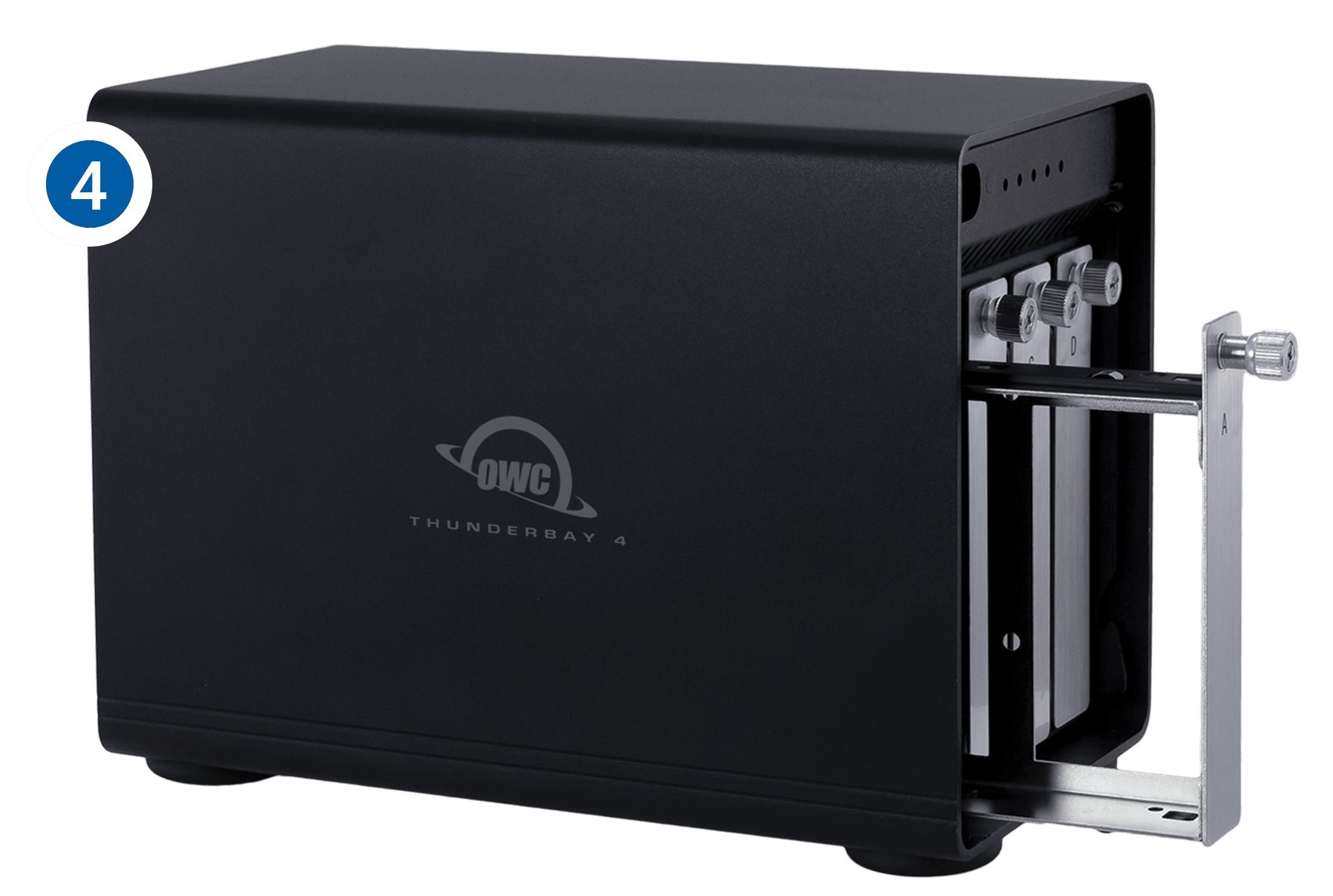
5. Set the drive tray as shown on your work surface. If you are replacing an existing hard drive, unscrew it from the drive tray at this time. NOTE: the highlighted screw holes are for 2.5-inch drives. The holes for 3.5-inch drives are highlighted in green (Step 7).
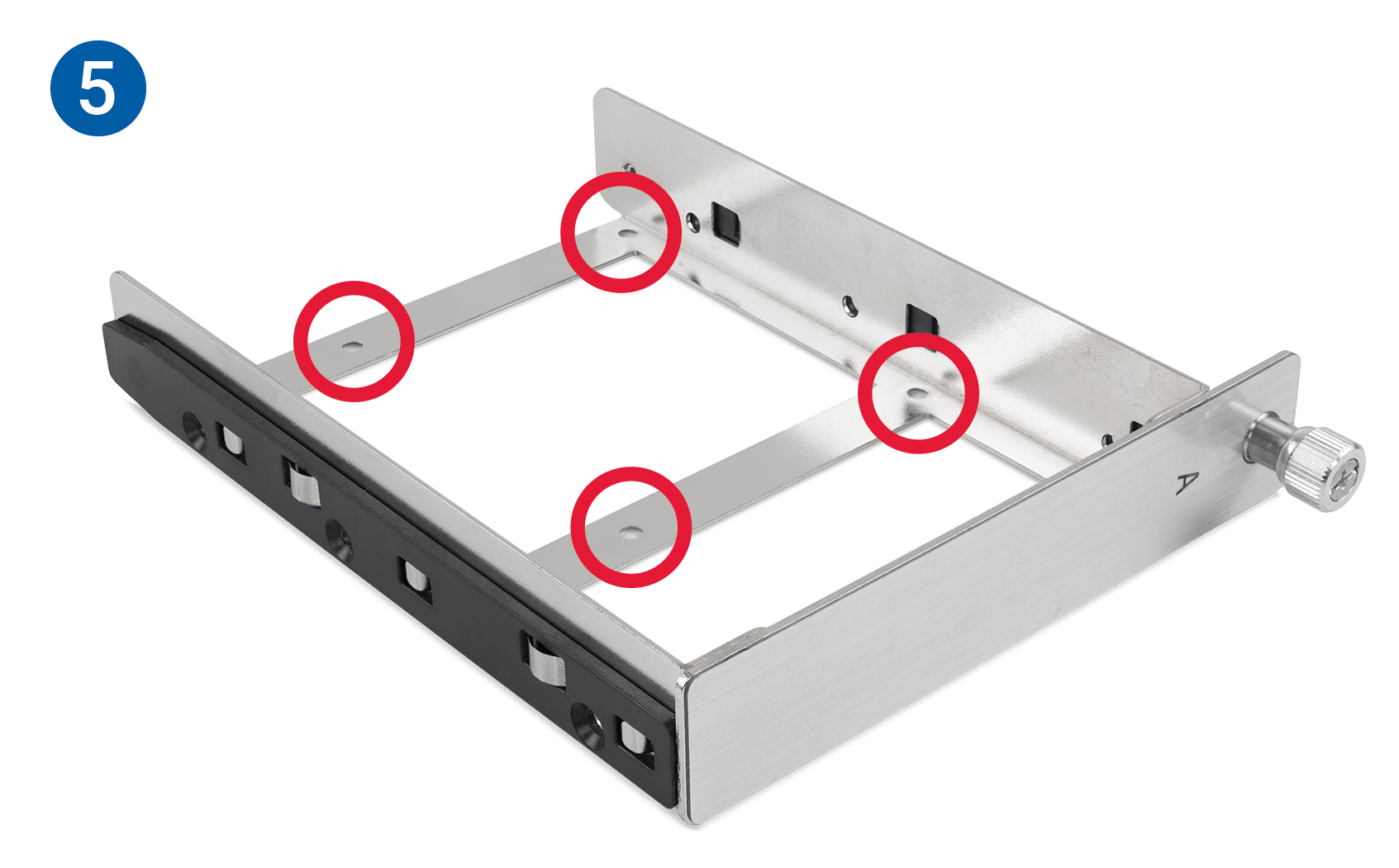
6. Place the hard drive inside the drive tray as shown. The label should face up and the SATA connectors should be on the far rear corner of the drive.
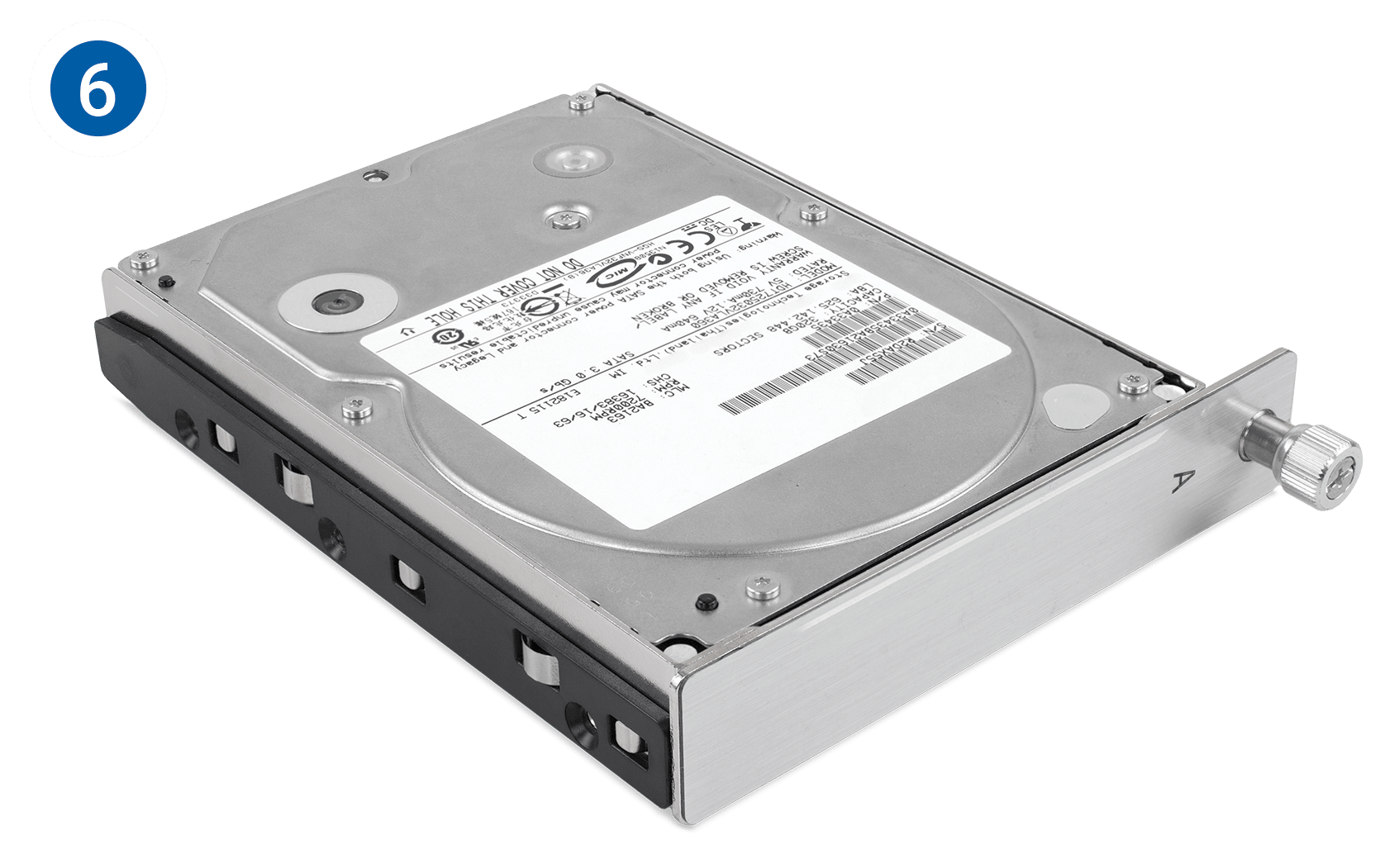
7. Fasten the drive into the drive tray using six of the included screws (three per side).
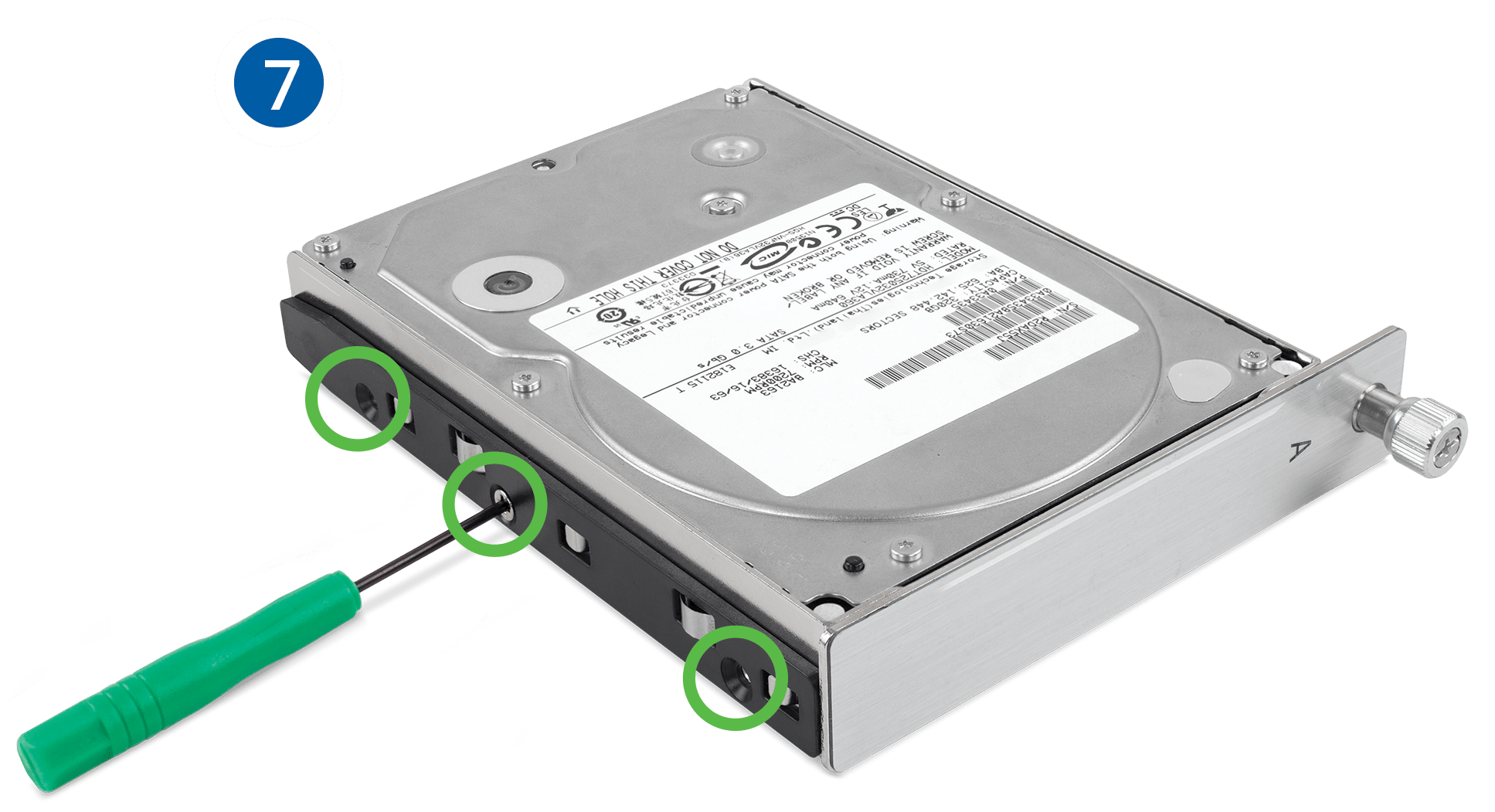
8. Slide the drive tray back into the rails in the ThunderBay 4 and push until it is seated fully, then push in on the thumbscrew and turn it clockwise until it stops turning. If you encounter resistance, do not force the drive tray. Remove it, check to make sure that there are no obstructions and that the drive tray is lined up correctly, then slide it in again.
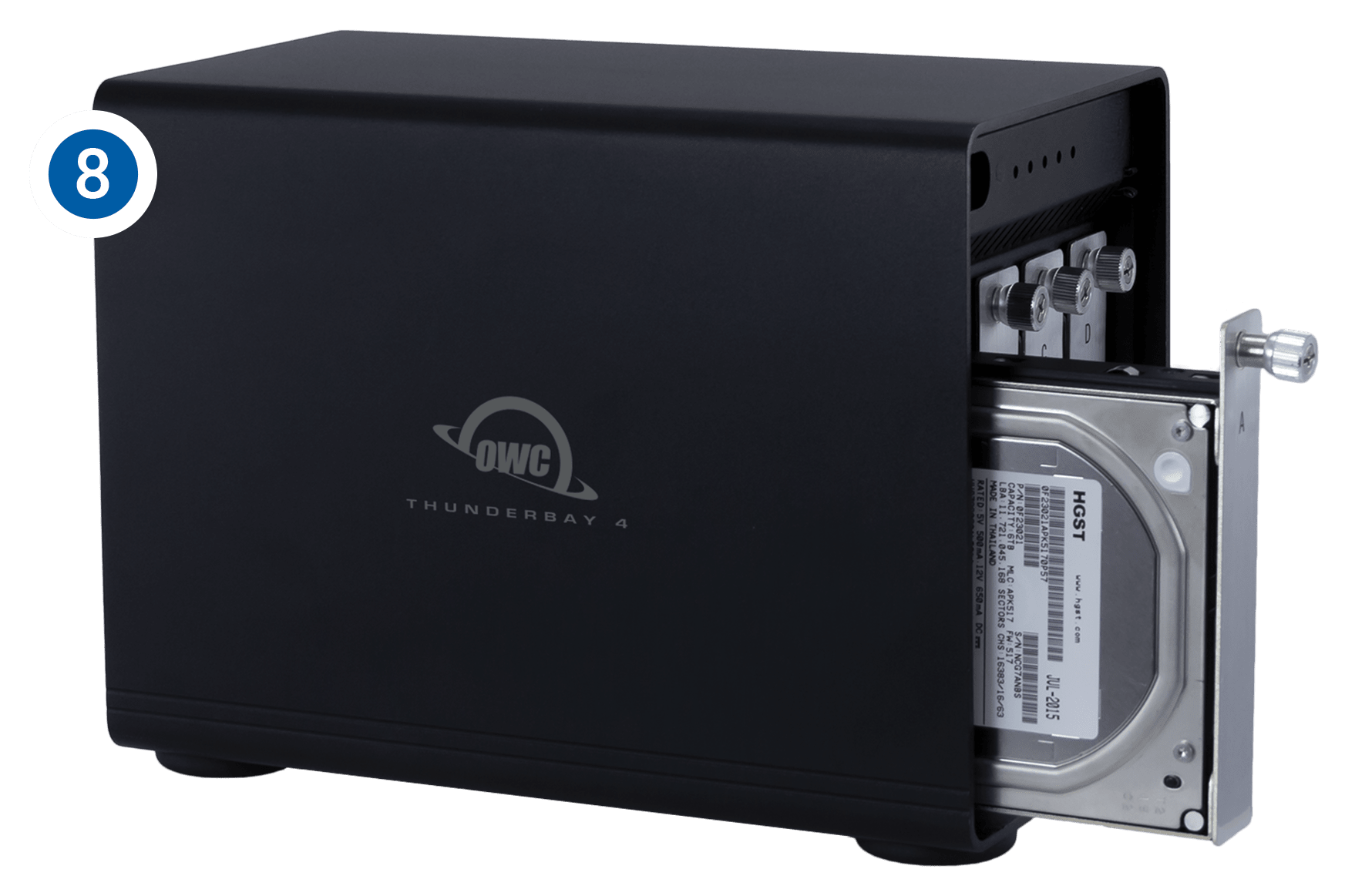
2.2 Quick Start
- Install hard drives into the ThunderBay 4 according to the instructions in Section 2.1 Hard Drive Installation.
- Connect the power cable to the enclosure and a power outlet, then make sure the ON/OFF switch is set to the ‘ON’ position.
- Connect a Thunderbolt cable between the ThunderBay 4 and a computer. When you do this, the ThunderBay 4 will turn on and the drives will be available for use on the computer.
- The OWC ThunderBay 4 is configured as an OWC SoftRAID RAID 5. Downloading and installing the latest version of SoftRAID is recommended to experience the best performance.
- NOTE: OWC ThunderBay 4 devices come bundled with "3 Years of SoftRAID Premium Access". Please visit OWC SoftRAID Product Details for more information regarding SoftRAID and the bundled Premium Access.
- NOTE: The OWC SoftRAID license is located on the bottom of the OWC ThunderBay 4.
2.3 Installing OWC SoftRAID
Mac SoftRAID Setup
- Download OWC SoftRAID for Mac.
- Please review and follow the steps outlined in OWC SoftRAID Installation for Mac.
Windows SoftRAID Setup
- If you are using the OWC ThunderBay 4 with the Windows operating system, the pre-installed drives need to be reconfigured before they can be used. The following options will allow the Mac formatted OWC ThunderBay 4 to work as a Windows formatted device.
- Download OWC SoftRAID for Windows
- Please review and follow the steps outlined in OWC SoftRAID Installation for Windows.
- Please consult the support article "Mac to Windows – SoftRAID Volume Conversation" for instructions to convert the Mac formatted OWC SoftRAID RAID 5 to a Windows formatted device through OWC SoftRAID.
- The Mac formatted OWC SoftRAID RAID 5 OWC ThunderBay 4 can be used in Windows through the purchase and installation of OWC MacDrive11 Pro. OWC MacDrive11 Pro allows access to software RAID Mac-formatted drives in Windows without performing a conversion process. Please visit OWC MacDrive Product Details or OWC MacDrive Support for more information.
2.4 Changing Drives & Drive Failure
You can add or remove any drive without needing to turn off the device or to unmount any of the other drives. Each drive operates independently of the others and is not affected by the addition or removal of another drive unless you set them up as members of a RAID array using software.
By itself, the ThunderBay 4 does not monitor drive health or alert you to a drive failure. You can monitor the health of your drives via SoftRAID in order to determine when a drive has failed or is in a pre-failure state. To replace a failed drive, simply remove the drive from its bay and replace it with another drive, following the steps in Section 2.1 Hard Drive Installation. The ThunderBay 4 does not need to be turned off during this process.
Support Resources
3.1 Troubleshooting
Begin your troubleshooting by verifying that the power cable is connected to the ThunderBay 4 and to a power source. If the power cable is connected to a power strip, make sure that the power switch on the strip is turned on. Then, verify that both ends of your cables are properly plugged into the computer and the ThunderBay 4.
If the ThunderBay 4 is still not working properly, try connecting to another computer or using another Thunderbolt cable. Remember that the ThunderBay 4 needs an active data signal in order for the power to remain on. If it is disconnected from the computer, or if the computer goes to sleep or turns off, the ThunderBay 4 will go to sleep. If you are still experiencing problems, consult Section 3.4 for OWC technical support contact information.
3.2 About Data Backup
To ensure that your files are protected and to prevent data loss, we strongly suggest that you keep two copies of your data: one copy on your OWC ThunderBay 4 and a second copy on your internal drive or another storage medium, such as an optical backup, or on a second external storage unit. Any data loss or corruption while using the ThunderBay 4 is the sole responsibility of the user, and under no circumstances may OWC, its parent, partners, affiliates, officers, employees, or agents be held liable for loss of the use of data including compensation of any kind or recovery of the data.
3.3 Online Resources
Changes
The material in this document is for information purposes only and subject to change without notice. While reasonable efforts have been made in the preparation of this document to assure its accuracy, OWC, its parent, partners, affiliates, officers, employees, and agents assume no liability resulting from errors or omissions in this document, or from the use of the information contained herein. OWC reserves the right to make changes or revisions in the product design or the product manual without reservation and without obligation to notify any person of such revisions and changes.
FCC Statement
Warning! Modifications not authorized by the manufacturer may void the user’s authority to operate this device.
NOTE: This equipment has been tested and found to comply with the limits for a Class B digital device, pursuant to Part 15 of the FCC Rules. These limits are designed to provide reasonable protection against harmful interference in a residential installation. This equipment generates, uses and can radiate radio frequency energy and, if not installed and used in accordance with the instructions, may cause harmful interference to radio communications. However, there is no guarantee that interference will not occur in a particular installation. If this equipment does cause harmful interference with radio or television reception, which can be determined by turning the equipment off and on, the user is encouraged to try to correct the interference by one or more of the following measures:
- Reorient or relocate the receiving antenna.
- Increase the separation between the equipment and receiver.
- Connect the equipment to an outlet on a circuit different from that to which the receiver is connected.
Health and Safety Precautions
- Read this user guide carefully and follow the correct procedures when setting up the device.
- Use proper anti-static precautions while performing the installation of your hard drives into this drive enclosure. Failure to do so can cause damage to your drive mechanisms and/or the hard drive enclosure.
- Do not attempt to disassemble or modify the device. To avoid any risk of electrical shock, fire, short-circuiting or dangerous emissions, never insert any metallic object into the device. If it appears to be malfunctioning, contact OWC technical support.
- Never expose your device to rain, or use it near water or in damp or wet conditions. Never place objects containing liquids on the drive, as they may spill into its openings. Doing so increases the risk of electrical shock, short-circuiting, fire or personal injury.
General Use Precautions
- Do not place objects on top of the device.
- To avoid damage, do not expose the device to temperatures outside the range of 5° C to 40° C (41° F to 104° F).
- Always unplug the device from the electrical outlet if there is a risk of lightning or if it will be unused for an extended period of time. Otherwise, there is an increased risk of electrical shock, short-circuiting or fire.
- Do not use the device near other electrical appliances such as televisions, radios or speakers. Doing so may cause interference which will adversely affect the operation of the other products.
- Do not place the device near sources of magnetic interference, such as computer displays, televisions or speakers. Magnetic interference can affect the operation and stability of hard drives.
- Protect your device from excessive exposure to dust during use or storage. Dust can build up inside the device, increasing the risk of damage or malfunction.
- Do not block any ventilation openings on the device. These help to keep the device cool during operation. Blocking the ventilation openings may cause damage to the device and cause an increased risk of short-circuiting or fire.
Warranty
The OWC ThunderBay 4 has up to a 5 Year OWC Limited Warranty. For up-to-date product and warranty information, please visit the product web page.
Copyrights and Trademarks
No part of this publication may be reproduced, stored in a retrieval system, or transmitted in any form or by any means, electronic, mechanical, photocopying, recording or otherwise, without the prior written consent of OWC.
© 2020 Other World Computing, Inc. All rights reserved. OWC, the OWC logo, and ThunderBay are trademarks of New Concepts Development Corporation, registered in the U.S. and/or other countries. Apple, Bootcamp, Mac, macOS, and OS X are trademarks of Apple Inc., registered in the United States and other countries. Thunderbolt and the Thunderbolt logo are trademarks of Intel Corporation or its subsidiaries. Microsoft and Windows are either registered trademarks or trademarks of Microsoft Corporation in the United States and/or other countries. Other marks may be the trademark or registered trademark property of their owners.
Free Support Chat
Our free award-winning support team is ready to answer all of your questions. Technical support is available Monday - Friday: 9AM - 6PM. Customer Support & Sales is available Monday - Friday: 9AM - 6PM. Support is unavailable on U.S. Federal holidays. Talk to a human today.

 1-800-275-4576
1-800-275-4576